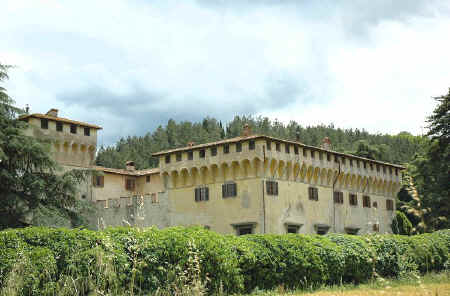
Villa Medicea di Cafaggiolo |
||
The history of the Castello Mediceo di Cafaggiolo in the Mugello |
||
|
Villa Cafaggiolo |
Castello Medicea di Cafaggiolo in the Mugello near Florence
|
The
Villa Medicea di Cafaggiolo (also known as Castello Mediceo di
Cafaggiolo) is a castellated Renaissance villa situated near Barberino di Mugello in the valley of the River
Sieve (Val di
Sieve), some 25
km north of Florence. It was one of the oldest and most favoured of the Medici family estates, having been in the possession of the family since the
14 C, when it was owned by Averardo de'
Medici. Averardo's son, Giovanni di Bicci de'
Medici, is considered to be the founder of the Medici
dynasty of Florence. |
History of CafaggioloDuring the
15 C and 16 C, the Tuscan aristocracy, who had forsaken their mediaeval castles for the political
value, comfort and greater security of town life, developed an aesthetic awareness which
encouraged the seasonal occupation of a country retreat for reasons
other than the annual harvests and hunting season. The new humanist values they
were beginning to absorb were best explored and discussed in an attractive country setting, enhanced by a
garden. The revival of Classical culture was accompanied by a conscious
development of the gardens
of the Tuscan villas
as extensions of the villas themselves. The first of these villas were built by the Medici family, whose affluence coincided with the beginning of the Renaissance period,
ca. 1420. The builder of Villa Medicea di Cafaggiolo was Cosimo de'
Medici, whose villa at Careggi is considered to be the model for the Renaissance villas of
Florence. These early villas as in the case at both Careggi and Villa Medicea di Cafaggiolo were the result of the complete rebuilding of existing Medici castles. |
Architecture of Villa Cafaggiolo
Unlike many of the Tuscan residences created by the Medici family, Villa Medicea di Cafaggiolo does not adhere
precisely to the ideals of Renaissance architecture. This is not because of
when it was constructed - 1452 - the year Michelozzo was charged with transforming the building from castle to villa. The first true Renaissance building, the Ospedale degli Innocenti in Florence, had been designed as early as
1419, and Michelozzo had proved his understanding of the new form in 1444 with his design for the ten-sided extension to Florence's Chiesa della SS. Annunziata inspired by a plan from the Roman temple of Minerva
Medica, and between 1444 and 1460 he constructed the first of the 15 C Renaissance palazzos, the
Medici-Riccardi for Cosimo de' Medici. This palazzo provides possible reason for the conservative design of the castle - Cosimo had been heavily criticised in Florence by the nobility for what was considered the pretentious design of the more Renaissance-style Palazzo
Medici-Riccardi. More about the Renaissance villas of Tuscany. Gardens of Villa CafaggioloUtens' view
shows the layout of the gardens and depicts green grass, fountains and
shrubs that were all symbols of the greatest luxury in the parched Tuscan landscape. More about the gardens of the Tuscan villas. |
Lunette by Utens (1599) illustrating Villa Cafaggiolo
Cafaggiolo maiolicaA ceramics manufactory was built alongside the castle for the production of everyday objects and also of more valuable items. The long outbuilding to the left of the castle in the Utens lunette above was known as the Manica Lunga, the "long wing". This building was used for the manufacture of the tin-glazed earthenware known as maiolica. The 1498 inventory notes that the fornaze col portico da cuocere vaselle ("kilns for baking pottery") in the piazza murata (walled enclosure) were let to Piero and Stefano foraxari, the "kilnmasters" of the maiolica manufactory for which Cafaggiolo is famed. These are Piero and Stefano di Filippo da Montelupo, who started up the kilns under Medici patronage in 1495. A plate manufactured in the Fabbrica di Cafaggiolo is exhibited at London's Victoria and Albert Museum. |
Mugello Tuscany © ammonet IntoTech 2007 - 2020